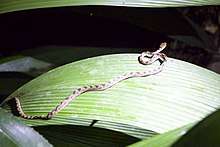Leptodeira septentrionalis
Leptodeira septentrionalis, the northern cat-eyed snake, is a species of medium-sized, slightly venomous snake,[2] found from southern Texas to northern Colombia.[3]
| Leptodeira septentrionalis | |
|---|---|
 | |
| A northern cat-eyed snake (Leptodeira septentrionalis), taken at Golfo Dulce Retreat, Golfo Dulce, Costa Rica | |
| Scientific classification | |
| Kingdom: | Animalia |
| Phylum: | Chordata |
| Class: | Reptilia |
| Order: | Squamata |
| Suborder: | Serpentes |
| Family: | Colubridae |
| Genus: | Leptodeira |
| Species: | L. septentrionalis |
| Binomial name | |
| Leptodeira septentrionalis Kennicott, 1859 | |
Appearance

The northern cat eye is medium size (up to 1 m).[4] In general females are slightly longer than males. They have smooth scales, with dark brown line or spot beside the eye and dark brown blotches (which can fuse to form a zigzag) running down their backs, these spots may vary in pattern geographically. Its head is distinctly wider than its neck and it has large bulging eyes with reddish irises and light brown elliptical pupils.[2]
Behaviour
The northern cat eye is primarily arboreal and entirely nocturnal. At night it hunts for frogs and their eggs, it is particularly known for feeding on those of the red-eyed tree frog.[2] It swallows eggs and small frogs alive but kills larger frogs with mild venom from its enlarged, grooved rear fangs. When threatened it is able to flatten its head and spread its jaws although it rarely bites people.
Reproduction and development
The Northern cat eye is oviparous and produces clutches of 6–13 eggs. As in other snake species delayed egg fertilisation can occur (fertile eggs can be laid up to several years after copulation). Developing snakes are nourished by a yolk sac for 79 to 90 days at which time they break through the outer shell using an egg tooth.[5] The egg tooth is lost after hatching. Young northern cat-eyed snakes appear identical to adults but feature much fresher coloration. The snakes will continue to grow throughout their entire lives.[6][7]
Distribution
The northern cat eye if found in many North American countries: US (S Texas), Mexico (Chiapas, Nuevo León, Quéretaro, Oaxaca, Puebla, Coahuila, Jalisco, Campeche, Yucatán, Quintana Roo, Nayarit), Guatemala, Honduras, Belize, El Salvador, Nicaragua, Costa Rica, Panama, Colombia (Valle del Cauca), northern Peru and Ecuador. It is found at elevations of 0–1940 m above sea level.[8] As of August 2019 there are 375 observations on iNaturalist, from Texas to Peru.[9]
Within Costa Rica it is found on both Caribbean and Pacific coasts up to 1200m above sea level in a wide variety of habitats but most common at edges of ponds where amphibians breed. Including in Golfo Dulce.
References
- Bolívar, W.; Chaves, G.; Cisneros-Heredia, D.F.; Daza, J.; Flores-Villela, O & Gutiérrez-Cárdenas, P. (2017). "Leptodeira septentrionalis". IUCN Red List of Threatened Species. 2017: e.T197498A2490931. doi:10.2305/IUCN.UK.2017-2.RLTS.T197498A2490931.en. Retrieved 3 September 2019.
- The Wildlife of Costa Rica, A Field Guide. Bloomsbury. 2010. ISBN 9781408130094.
- https://www.iucnredlist.org/species/197498/2490931
- Amphibians and Reptiles of Costa Rica : A Pocket Guide. Cornell University Press. 2013. ISBN 9780801478697.
- Gentry, Bruce (2011). Leptodeira septentrionalis.
- Dixon, J.; Werler, J. (2000). Texas snakes: identification, distribution, and natural history. Austin: University of Texas Press. ISBN 978-0292791305.
- Lee, J. (2000). A FIELD GUIDE TO THE AMPHIBIANS AND REPTILES OF THE MAYA WORLD. Cornell University Press.
- Genus Leptodeira at The Reptile Database. www.reptile-database.org.
- https://www.inaturalist.org/taxa/29724-Leptodeira-septentrionalis
